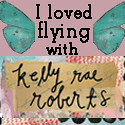First of all, let me explain that I was wiring a canvas. I prefer to paint on 1 1/2" or 2" deep gallery-wrapped canvases. That means, there are no staples on the sides. You could eventually frame the canvas, but it's not necessary because you have a smooth canvas look on the sides. This technique will still work for wooden framed canvases, though.
Here's the back of the painted canvas. You can see the staples on the back, but that doesn't matter.
Now, onto the the wiring.
These are the tools you will need: with a cutting capability, pencil, ruler, an awl, hanging wire, eye hooks, and later, the hanging pieces for the wall. The best way I can describe an eye hook is it's about 1/2" long and it looks like a lollipop. It is threaded like a screw, and the "eye", or open part, is what the wire goes through.
The rule of thumb is that the wire should go down about 1/3 from the top. Dare I say it? Please look at the front of your painting and make sure you have it right side up. You can use a ruler to figure out the third distance, then mark your spot with a pencil. Notice on my canvas that I am marking the spot on the wood only. You don't want the eye hooks screwed into the wood and the folded over canvas, just the wood.
Use the awl to poke a hole in the wood for the eye hook. Usually the wood on canvases is soft enough to do it this way. If it is too hard, use a small drill bit to drill a hole.
Start to screw in the eye hook. Poke the end of the awl into the eye and spin it around until it is screwed in tightly. Put in the eye hook on the other side the same way.
Cut a length of hanging wire about 1 1/2 times the width of the painting. The needle nosed pliers you are using should have a cutting part. Squeezing the wire tightly will cut through the wire.
One note about hanging wire. It is designed for hanging various weights. If you're making lightweight paintings, a 10 pound wire should be sufficient. You'll find that different brands of wrapped canvases use heavier woods, so you may need a heavier wire even if the canvas is a small dimension. If your canvas is 36" wide or more, you may want to use a heavier wire as well.
Thread the wire through both eye hooks so that an equal amount of wire is left over on each side. Wrap the end around the eye hook, then pass it back through the hook. Use the pliers to pull it tight. Do this for the other eye hook. The excess wire should be wrapped around the hanging wire.
One other note about wire: Some people prefer coated wire because it doesn't fray. I don't because it is slippery and the excess wire slides around when you wrap it. You can see that my wire is frayed here. I'll cut off the frayed portion before I am finished.
I always pull my wire tight. Over time, the wire will get loose, so I want to start with a tight wire.To hang your painting, check to make sure the hanger is rated to hold the weight of your painting. I use standard hanging hooks, which go into the wall with a little nail. Never put it in the wall in an existing hole -- there will be too much wiggle room and it may fall out. Always make a new hole.
One more thing: When giving up one of your paintings, either to hang in a gallery or show or when you sell it, make sure you put your name and the painting's title on the back. You can even tape your business card to the back. If it is important to note that this is an original, one-of-a-kind, you can note that too, or note if it is a numbered copy.
Hopefully, my instructions are sufficient. If you have any questions, drop me a comment here.





















































